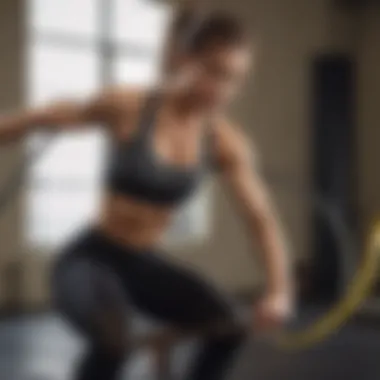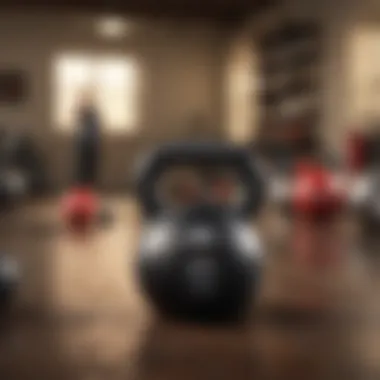Cross Training Gear: Essential Equipment for Performance


Intro
In a gym environment, cross training has gained substantial importance due to its comprehensive approach to fitness. This strategy combines various exercise modalities catering to distinct muscle groups and agility. Cross training encompasses a variety of activities including strength training, cardiovascular workouts, and flexibility routines. Its versatile nature requires adequate gear that supports different workout regimens, enhancing performance and overall results.
With the rise of cross training among professionals, understanding the specific gear becomes essential. The right equipment can significantly impact physical conditioning, injury risk, and mental focus. This article discusses critical gear for cross training, elucidates on technology advancements, and analyzes current market trends.
Key Benefits
Investing in proper cross training gear yields significant advantages, not only for physical transformation but also for mental resilience.
Physical Health Benefits
Physical health benefits are most obvious and multifaceted.
- Enhanced strength through resistance training gear.
- Improved cardiovascular endurance with specialized footwear and equipment.
- Increased flexibility and range of motion through the use of mats and bands.
Every piece of equipment plays a unique role in enhancing specific areas of fitness, thus facilitating a holistic improvement. The appropriate gear can also lead to lower injury rates. By using well-designed tools, practitioners can minimize stress on vulnerable areas, like joints.
Mental Well-being Enhancements
Cross training does not only contribute to physical attributes but also plays a critical role in mental well-being.
- Engaging in diverse workouts can boost motivation, keeping routines fresh and engaging.
- The social aspect of group training fosters a sense of community.
- Accomplishing varied challenges builds confidence and enhances focus.
Maintaining mental resilience has become increasingly important in today's fast-paced life. Therefore, the right cross training gear serves dual purposes by supporting both mental and physical health improvements.
"Optimal performance is achieved when the right mindset is coupled with appropriate training tools."
Practical Tips
To maximize benefits from cross training, integrating effective strategies is key.
Effective Meal Planning
Nutrition plays a fundamental role in performance. Planning meals that are tailored to support diverse workout styles ensures that energy levels remain consistent. Focus on:
- A balanced intake of proteins, carbohydrates, and fats.
- Meal timing that aligns with training schedules.
- Hydration to complement physical exertion.
Quick and Efficient Workouts
The modern lifestyle often demands quick and effective workout options. Incorporating circuits that use minimal equipment can lead to substantial gains in a short time frame. Use compact gear like dumbbells or resistance bands to create versatile workout routines that can be completed in less than 30 minutes.
These strategies reinforce the connection between proper training gear, effective meal planning, and overall fitness goals.
Understanding Cross Training
Cross training represents a comprehensive approach to fitness that encompasses various workout styles and methods. It aims to enhance athletic performance while reducing the risks of injury. The importance of understanding this concept is crucial, especially in the context of the current fitness landscape, where specialization can sometimes lead to imbalances and overuse injuries. By diversifying workouts through cross training, individuals can optimize their physical capabilities and enjoy a more holistic fitness routine.
Definition and Purpose
Cross training refers to the practice of engaging in different types of exercise to improve overall performance. It often includes a mix of aerobic, strength, flexibility, and mobility work. The purpose of cross training is to develop multiple fitness components, ensuring that one area of fitness does not compromise another. This variety not only enhances physical capability but also keeps the training stimulating.
Incorporating a range of activities reduces the monotony that can come with sticking to a single workout routine. For example, a runner may include swimming or strength training to enhance endurance and muscular strength. The result is not only improved performance but also a reduced risk of repetitive strain injuries that can occur with rigorous training of one specific sport or activity.
Benefits of Cross Training
The benefits of cross training are myriad and can directly influence overall health outcomes. Here are some key advantages:
- Injury Prevention: By spreading the physical demands across various muscle groups, cross training can help to prevent the overuse injuries that frequently occur through repetitive strain in specific activities.
- Improved Performance: Engaging in different types of training can improve various aspects of athleticism, such as speed, strength, and agility. For instance, strength training can enhance power for runners, while flexibility exercises can improve range of motion.
- Enhanced Motivation: Shifting between different activities can maintain engagement and enthusiasm, making individuals more likely to stick with their exercise programs in the long run.
- Balanced Muscle Development: Different exercises target different muscle groups. Cross training helps to ensure balanced muscle development, which is crucial for overall body functionality and injury prevention.
"Research indicates that athletes who engage in cross training often experience a 15-20% improvement in their primary sport compared to those who do not."


Overall, understanding cross training provides a foundation for selecting the appropriate gear and equipment that will facilitate diverse workouts while allowing for optimal performance. Knowing its definition and benefits helps individuals to appreciate the role that the right gear plays in effectiveness and safety during their fitness journey.
Key Components of Cross Training Gear
Understanding the key components of cross training gear is essential for optimizing performance and ensuring a safe workout environment. Each component plays a crucial role in how effectively one can engage in diverse and demanding physical activities. The right gear can enhance comfort, improve efficiency, and help prevent injuries. In this section, we will explore three primary components: shoes, apparel, and accessories. Each of these elements contributes significantly to the overall cross-training experience.
Shoes for Cross Training
Types of Cross Training Shoes
When it comes to types of cross training shoes, they are specifically designed for versatility. They often combine features found in running shoes, weightlifting shoes, and gym shoes. This fusion allows trainers to effectively transition between various forms of exercise without needing to change footwear. A key characteristic of these shoes is their stability. Stability plays an important role when performing dynamic movements such as jumps and lateral drills. Popular models may include the Nike Metcon and Reebok Nano, known for their excellent support during high-impact activities. However, they might not offer sufficient cushioning for long-distance running.
Shoe Features to Consider
Selecting the right shoe involves considering several features. Traction is a major element that directly influences performance. Shoes should have a multidirectional grip to prevent slipping during quick directional changes. Comfort is another essential feature, as poor fitting shoes can lead to discomfort and ultimately injury. A notable unique feature is the flexibility allowing natural foot movement. While structured shoes offer support, overly stiff shoes can impede performance. When weighing your options, ensure that the shoe offers a balance of support and flexibility relevant to your training needs.
Top Brands and Models
Exploring top brands and models can inform your purchasing choices. Brands like Asics and Under Armour have gained a reputation for quality cross-training shoes. Asics Gel series is celebrated for its superior cushioning providing comfort during intensive workouts. Under Armour's HOVR series also boasts excellent energy return technology. These distinctive features can enhance performance but may come with a higher price tag. Finding the right blend of affordability and quality is crucial when selecting footwear for cross training.
Apparel Considerations
Fabric Types and Their Benefits
Fabric choice is vital for cross training apparel. Breathable fabrics such as polyester and nylon wick sweat away, keeping you dry and comfortable. This moisture management can improve overall workout performance. A unique benefit of synthetic fabrics is durability. They hold up against rigorous exercises better than cotton, which can lose its shape or retain moisture. However, one should be cautious of using too much synthetic fabric, as it might lead to overheating in warm conditions.
Fit and Functionality
When evaluating fit and functionality, it becomes apparent that properly fitting gear boosts confidence and comfort. Loose garments can hinder movement, while overly tight clothing can restrict blood circulation. The right fit should allow free range of motion during exercises. Compression garments, for instance, provide support and improve circulation, often resulting in better endurance during high-intensity workouts. Yet, finding the right balance between fit and functionality is essential to avoid discomfort or distraction.
Layering for Performance
Layering appropriately can also enhance performance depending on the workout environment. Base layers manage moisture close to the skin, while mid layers provide insulation if it’s cold. An outer layer offers wind and water resistance. Understanding how to layer can help maintain optimal body temperature throughout various training sessions. However, wearing too many layers can restrict movement and create discomfort, which may ultimately impair performance.
Accessories Enhancing Performance
Wrist and Ankle Weights
Wrist and ankle weights are popular due to their ability to enhance strength through added resistance. These accessories can lead to greater muscle activation during exercises like lunges and arm movements. The key characteristic of these weights is their adjustability; many sizes allow users to adjust the resistance according to their fitness level. However, overuse might lead to strain, so it’s important to use them judiciously.
Resistance Bands
Resistance bands are versatile tools for strength training and flexibility exercises. These bands can effectively target specific muscle groups and support joint stability. A notable strong point is their portability; they can easily fit into a bag or backpack. However, they require proper technique to avoid injury, as improper use can lead to unexpected strain.
Jump Ropes
Jump ropes offer a superb cardiovascular workout and enhance coordination. The rhythmic motion helps in building stamina while being low in equipment requirement. They engage multiple muscle groups, delivering a full-body workout. A disadvantage might be the learning curve; beginners may find it challenging to maintain rhythm. Nonetheless, incorporating jump ropes into a training routine adds variety and intensity.
"When it comes to cross training, the right components can significantly improve both performance and safety during workouts. The synergy between shoes, apparel, and accessories is paramount."
Types of Cross Training Equipment
Understanding the various types of cross training equipment is pivotal in enhancing overall fitness performance. This section delves into the essential gear needed to support a diversified workout regime. Each piece of equipment plays a unique role, catering to different training needs and fitness levels. The right equipment not only boosts performance but also helps in preventing injuries, allowing for a safer and more effective training experience.
Strength Training Gear
Dumbbells and Barbells
Dumbbells and barbells are fundamental tools for strength training. Their versatility enables a wide range of exercises, crucial for building muscle strength. A significant characteristic of these weights is their adjustability. This feature allows users to increase weight gradually. Dumbbells are particularly popular because they facilitate isolated movement and aid in balance improvement.
In contrast, barbells enable the use of heavier weights, making them suitable for compound movements. A unique aspect of both is their contribution to varied muscle engagement. However, users must be cautious as improper form can lead to injuries.


Kettlebells
Kettlebells have gained popularity due to their multifunctional use. They not only enhance strength but also improve cardiovascular endurance. The design of a kettlebell allows for dynamic movements, combining strength training with aerobic benefits. A key characteristic is its off-center weight, which challenges stability and control during workouts.
This equipment provides a unique feature of enhancing grip strength. However, they require a certain level of technique to maximize benefits and avoid strain.
Weight Machines
Weight machines are designed to guide users through specific movements. This characteristic makes them particularly beneficial for beginners or those recovering from injuries. Machines provide consistent resistance and can help in isolating certain muscle groups, which is advantageous for a focused workout.
A unique feature is their built-in safety. Many machines prevent users from lifting beyond their capacity, reducing the risk of injury. However, they may limit the range of motion, which could impact functional strength over time.
Cardio Equipment
Treadmills
Treadmills are popular for their convenience and versatility in cardiovascular training. They allow for adjustable speed and incline, catering to various fitness levels. A major benefit is the ability to simulate outdoor running in a controlled environment.
The unique feature of interactive screens in modern treadmills can enhance the workout experience, providing motivation through virtual runs. However, repeated use can lead to joint strain, making proper form essential.
Rowing Machines
Rowing machines provide a full-body workout, emphasizing both strength and cardio. This equipment engages multiple muscle groups simultaneously, enhancing overall fitness. The adjustable resistance makes it suitable for users at different fitness levels.
A unique feature is the capability to mimic the motions of rowing, which is beneficial for developing both upper and lower body strength. However, improper technique can lead to back strain, so attention to form is crucial.
Stationary Bikes
Stationary bikes offer a low-impact alternative for cardio workouts. They are particularly beneficial for those looking to improve endurance while minimizing joint stress. The adjustability of resistance levels allows riders to tailor their workouts to changing fitness goals.
A shared characteristic with outdoor cycling, stationary bikes can provide a satisfying workout. However, prolonged use without proper adjustments may lead to discomfort and does not fully engage upper body muscles, thus limiting upper body strength benefits.
Functional and Mobility Tools
Medicine Balls
Medicine balls play a significant role in functional training. They are used for various exercises that engage core muscles and improve overall strength. A characteristic feature is their versatility; they can be incorporated into strength, balance, and conditioning workouts.
This equipment helps in developing explosive strength while enhancing coordination. However, care should be taken to ensure that the weight is suitable to avoid injury during throws and carries.
Foam Rollers
Foam rollers are essential for recovery and muscle maintenance. They facilitate self-myofascial release, which helps in loosening tight muscles. A prominent characteristic is their ability to aid in post-workout recovery, reducing soreness and improving flexibility.
Their unique feature is also the affordability and accessibility, making them an essential item for any fitness enthusiast. However, improper use may lead to discomfort, so users should learn the correct application techniques.
Balance Trainers
Balance trainers, such as stability balls or balance boards, focus on enhancing core stability and coordination. They challenge the body's balance in various exercises, which is crucial for overall fitness. A key characteristic is their capacity to engage stabilizing muscles, often neglected in traditional workouts.
One unique feature is their versatility; they can be used in strength, balance, and flexibility workouts. However, they may not be suitable for all fitness levels, as beginners may struggle with coordination.
Selecting the Right Gear for You
Choosing the right gear for cross training is foundational for any fitness enthusiast. Each person has unique needs based on their goals and fitness levels. An informed decision helps in maximizing workout efficacy and preventing injuries. Proper gear can enhance performance, boost motivation, and make workouts more enjoyable.
Assessing Your Fitness Goal
Understanding your fitness goals is crucial. Whether you aim to lose weight, build muscle, or enhance endurance, each objective requires different gear. For example, someone focused on weightlifting needs sturdy shoes and versatile equipment. In contrast, an individual aiming for cardio fitness may benefit from high-quality running shoes and effective resistance bands.
- Weight Loss: If your goal is shedding pounds, you should consider gear that supports varied, high-intensity workouts. Sneakers with good grip and comfort can enhance your cardio sessions.
- Muscle Gain: For building muscle, equipment like dumbbells, kettlebells, and resistance bands is important. Focus on gear that allows for diverse movements and exercises targeting different muscle groups.
- Endurance: If endurance is your aim, especially in sports like running or cycling, look for breathable apparel and well-cushioned footwear. Also, equipment like jump ropes can be effective for enhancing cardiovascular endurance.


Determining Your Fitness Level
Assessing your current fitness level involves understanding your capabilities. This process helps in selecting appropriate gear that matches your training intensity and allows for progression.
- Beginner: If you're starting out, prioritize comfort and versatility. Basic shoes and basic tools like resistance bands and light weights are often sufficient.
- Intermediate: At this stage, individuals may consider expanding their collection. Investing in specialized shoes or varied weights will allow for more diverse workouts.
- Advanced: For the veteran athlete, high-performance gear is useful. This might include advanced weightlifting shoes or multi-use equipment designed for complex movements.
Evaluating these elements will ensure that you invest thoughtfully in your cross training gear. Each piece of equipment should serve a purpose while facilitating growth in your fitness journey. By aligning your gear with your goals and fitness level, you pave the way for success in your training.
Maintenance and Care of Cross Training Gear
Maintaining and caring for cross training gear prolongs its lifespan and ensures optimal performance. Regular upkeep prevents deterioration and malfunctions, which can hinder workouts. Many do not realize that proper maintenance can also safeguard against injuries caused by worn-out equipment. Just as athletes invest in quality gear, they should prioritize care routines that enhance functionality and ensure safety.
Cleaning Your Gear
Cleaning is an essential aspect of gear maintenance. Accumulation of sweat, dirt, and grime can degrade materials over time. Here are some cleaning tips:
- Fabric and Shoes: Determine the correct cleaning method for materials. For athletic shoes, it’s often recommended to remove the insoles and laces. Hand washing with mild soap and air drying is typically best. Avoid machine washing, as it might deform the structure.
- Equipment: Regularly wipe down machines and weights with disinfectant wipes or alcohol solutions. This removes bacteria and residues.
- Frequency: Establish a cleaning schedule, ideally after every intense workout session. This prevents buildup and keeps gear in working condition.
Important Reminder: Some materials may require specific cleaning solutions or impermeable coverings. Always check care labels or manufacturer instructions.
"Regular cleaning of your gear not only extends its life but also promotes a healthy workout environment."
Storage Solutions
Proper storage of gear is equally significant. Disorganized storage can lead to accidental damage and make finding equipment challenging. Consider the following storage tips:
- Cool, Dry Places: Store gear in a location that minimizes moisture, heat, and excessive light exposure. These factors can degrade materials.
- Organization: Use bins, racks, or shelves to organize items. Categorize them, like shoes, weights, and smaller accessories, making retrieval easier.
- Covers and Cases: Employ protective covers for machines and other susceptible equipment. This lessens the risk of scratches and exposure to dust.
Consider: For larger equipment, such as treadmills, ensure adequate space around them for easy access. This will help maintain functionality and provide a safer workout space.
In summary, regular cleaning and proper storage of cross training gear are vital for safety and effectiveness. A diligent maintenance routine will not only enhance performance but also contribute to a more pleasant workout experience.
Market Trends in Cross Training Gear
In the ever-evolving world of fitness, it is crucial to keep an eye on market trends in cross training gear. This section highlights current developments and focuses on the technologies making waves in the fitness industry. Understanding these trends informs potential buyers, helping them to adapt their gear choices to their training needs and personal values. The days of simply choosing a piece of equipment based on price alone are fading. Today, consumers are more discerning, seeking quality, functionality, and sustainability in their purchases.
Innovations in Technology
Advancements in technology play a more significant role in cross training gear than ever before. Manufacturers are integrating sophisticated features that not only enhance performance but also improve user experience. Key areas of innovation include:
- Smart Fabrics: Many brands are releasing apparel made from moisture-wicking materials that also offer temperature regulation. These fabrics help in maintaining comfort during intense workouts.
- Wearable Technology: Fitness trackers and smartwatches, like the Fitbit or Apple Watch, are now common. They provide valuable data on heart rates, calories burned, and workout duration. This type of information empowers users to optimize their training.
- Adaptive Equipment: Machines that adjust resistance or incline dynamically based on the user’s performance are becoming more prevalent. This technology enables more personalized workouts.
"Investing in technology-enhanced gear not only boosts performance but can also drive motivation, as users see their progress in real-time."
These innovations hold great promise. They contribute to safer workouts, allowing individuals to track their progress and adjust their routines effectively. Importantly, technological gear often appeals to younger audiences who expect high-tech solutions.
Sustainability in Gear Production
The fitness industry is increasingly recognizing the necessity for sustainable practices. Sustainability has become a top priority for many consumers concerned about environmental impact. Here are notable aspects of sustainability in cross training gear:
- Eco-friendly Materials: Brands are turning to recycled materials in their manufacturing processes, reducing their carbon footprint. Materials like recycled polyester and organic cotton are gaining popularity.
- Durability over Disposability: Many companies focus on producing gear designed to last longer, minimizing waste. Consumers are shifting their mindset from fast fashion to investing in high-quality equipment that endures.
- Ethical Manufacturing: Transparency in production processes has become essential. Brands that demonstrate fair labor practices and environmental responsibility are receiving favorable attention from discerning consumers.
Ending: Investing in Cross Training Gear
Investing in cross training gear is crucial for maximizing performance and achieving fitness goals. The gear you choose can significantly influence your workout efficiency and help prevent injuries. A well-selected set of equipment not only boosts your capabilities but also enriches your training experience.
Long-term Benefits
Investing in quality cross training gear offers several long-term benefits. First, it enhances overall performance. Proper shoes, for instance, improve stability and provide adequate support during mixed workouts that merge strength training with cardiovascular exercises. Over time, this can lead to improved strength, endurance, and coordination.
Second, high-quality gear often promotes safety. Gear designed for specific activities ensures that you engage in exercises with lower risk of injury. By choosing the right equipment, you minimize the likelihood of accidents that cause setbacks in your fitness journey.
In addition to safety, durability is another long-term benefit. Quality gear withstands wear and tear better than cheaper alternatives. Investing upfront reduces the need for frequent replacements. This long-term cost efficiency can be a significant factor for many fitness enthusiasts.
Final Recommendations
Selecting the right cross training gear can often feel overwhelming, given the vast array of options available. Here are some final recommendations to guide your choices:
- Prioritize Quality Over Cost: While budget is essential, focus on investing in high-quality gear that meets the demands of your training regimen.
- Understand Your Needs: Different types of cross training require different gear. Assess your personal fitness goals before purchasing.
- Test Before You Buy: If possible, try items like shoes or weights beforehand to ensure they suit your needs and fit correctly.
- Stay Informed: Regularly check reviews and expert guidance on new products and techniques. This helps you keep your gear updated and optimized for your training.















